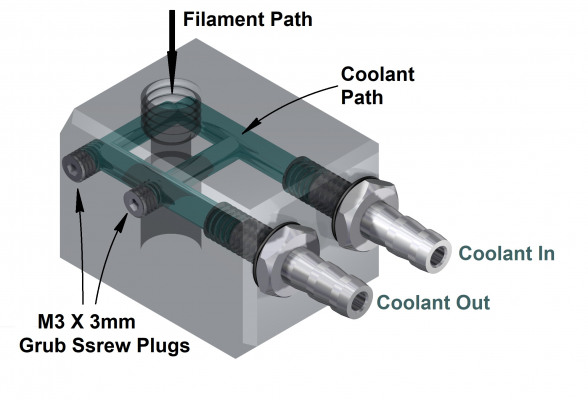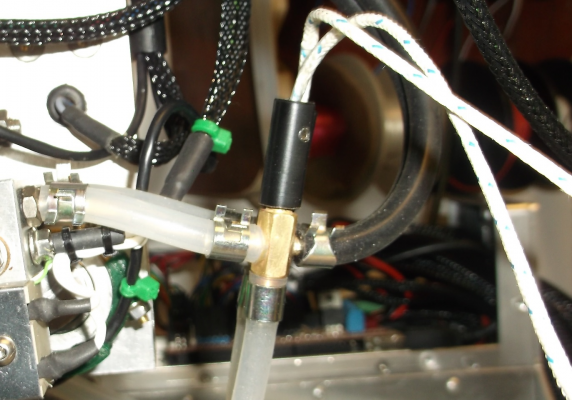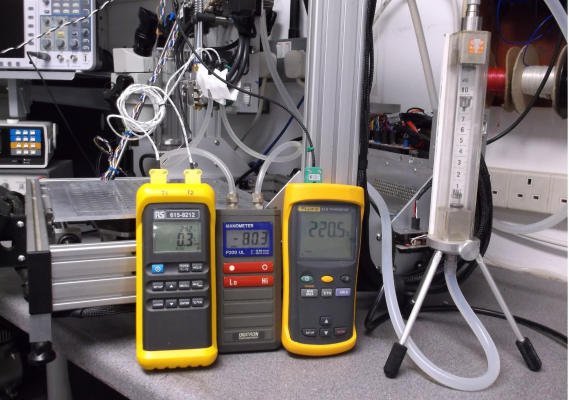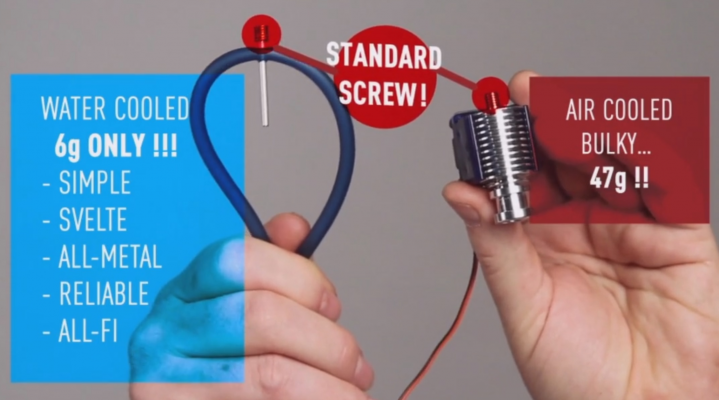Water Cooled Cold End tests
Posted by leadinglights
|
Water Cooled Cold End tests October 24, 2020 12:52PM |
Registered: 12 years ago Posts: 1,450 |
The first time I saw watercooling discussed on this forum the poster had soldered a straight bit of brass tubing at 90° to the stainless steel feed tube just above the heat break so that the cooling tube was touching at only one place. That user reported that it worked well. A more recent forum entry had somebody enclose the fins of an E3D V6 All-Metal hotend in a water jacket - a task that had to present some engineering challenges.
For myself, I designed my own watercooled hotend with some calculations but also with a bit of guesswork and with fingers crossed. Tests to date have been largely of the "Oh! that doesn't feel too warm" kind so I thought I would try to get some data. The fact that I am not on an Atlantic cruise or wandering the galleries of the Hermitage Museum in Saint Petersberg may also have a bit to do with it.
I have used one hotend on my Biceps two head printer for these tests: Hotend is a copper block with a resistor for heating, heatbreak is 4mm long 304 stainless steel of 4mm bore and 5.4mm o.d. and is lined with 2mm bore PTFE. The coldend is an aluminium block with galleries drilled in it for cooling. A drawing of the block showing the coolant path is below.
To measure the differential pressure I made two T pieces with outlets to the two sides of a manometer. There were also two K type thermocouples in the T pieces which are shown below.During tests the T pieces were thermally insulated from each other and the environment.
Instrumentation included a differential thermocouple thermomenter, the manometer mentioned above, a thermometer to measure the hotend temperature and a Platon Gapmeter to measure the flow. The setup below shows the instrumentation.
The results were: After an hour, with an ambient temperature of 21.5°C and with the hotend at 220°C and a coolant flow of 0.65L/min there was a temperature difference of between 0.3°C and 0.4°C. The temperature of the coldend block was 24.4°C.
I don't think anybody has to worry that their water jacket is not man enough for the task.
Mike
Edited 1 time(s). Last edit at 10/24/2020 12:56PM by leadinglights.
For myself, I designed my own watercooled hotend with some calculations but also with a bit of guesswork and with fingers crossed. Tests to date have been largely of the "Oh! that doesn't feel too warm" kind so I thought I would try to get some data. The fact that I am not on an Atlantic cruise or wandering the galleries of the Hermitage Museum in Saint Petersberg may also have a bit to do with it.
I have used one hotend on my Biceps two head printer for these tests: Hotend is a copper block with a resistor for heating, heatbreak is 4mm long 304 stainless steel of 4mm bore and 5.4mm o.d. and is lined with 2mm bore PTFE. The coldend is an aluminium block with galleries drilled in it for cooling. A drawing of the block showing the coolant path is below.
To measure the differential pressure I made two T pieces with outlets to the two sides of a manometer. There were also two K type thermocouples in the T pieces which are shown below.During tests the T pieces were thermally insulated from each other and the environment.
Instrumentation included a differential thermocouple thermomenter, the manometer mentioned above, a thermometer to measure the hotend temperature and a Platon Gapmeter to measure the flow. The setup below shows the instrumentation.
The results were: After an hour, with an ambient temperature of 21.5°C and with the hotend at 220°C and a coolant flow of 0.65L/min there was a temperature difference of between 0.3°C and 0.4°C. The temperature of the coldend block was 24.4°C.
I don't think anybody has to worry that their water jacket is not man enough for the task.
Mike
Edited 1 time(s). Last edit at 10/24/2020 12:56PM by leadinglights.
|
Re: Water Cooled Cold End tests October 26, 2020 11:06AM |
Registered: 12 years ago Posts: 1,450 |
I have done some preliminary tests by manually (software not set up yet) feeding PLA through the hotend, retracting the filament by 20mm then extending and feeding a couple of millimeters - repeating this approximately every 2 to 3 seconds for a minute. The temperature increase I read on the cold-end was about 0.7°C
Without the filament it looks like the cold-end is extracting somewhere around 3W to 4W of heat - this was with 10.4W fed to the hot-end. Although I did not measure the hot-end temperature when I was moving PLA through it, the fact that the plastic it remained somewhat molten shows that it was above about 180°C
My hot-end is not an all-metal kind, being PTFE to a bit over 50% of the heat break, I would be interested to know how much heat does get through to the cold-end on an all metal hot-end: Power extracted would be nice, but temperature rise above ambient whould give me a bit of a handle on it.
Mike
Without the filament it looks like the cold-end is extracting somewhere around 3W to 4W of heat - this was with 10.4W fed to the hot-end. Although I did not measure the hot-end temperature when I was moving PLA through it, the fact that the plastic it remained somewhat molten shows that it was above about 180°C
My hot-end is not an all-metal kind, being PTFE to a bit over 50% of the heat break, I would be interested to know how much heat does get through to the cold-end on an all metal hot-end: Power extracted would be nice, but temperature rise above ambient whould give me a bit of a handle on it.
Mike
|
Re: Water Cooled Cold End tests December 06, 2020 05:21AM |
Registered: 12 years ago Posts: 1,450 |
The results I got earlier in this thread, along with a discussion with deckingman [reprap.org] have made me look again at when can be done to make a lightweight hotend which can be used in a simplified heated Delta printer. Although this hotend is not working yet, this is only because I haven't yet made a heater element for it. I have little doubt that it will work well.
There is an old trick to bending copper tubing to a tight radius without it kinking - fill it with sand. For small tubes such as 3mm O.D. 2mm I.D., you will have to use something like kiln dried sand such as is sold for filling the gaps in block paving: Anything courser or with less rounded grains might leave voids or may not pour out after the bending is finished. I blocked one end of a 100mm length of copper tube by flattening it in the vise then filled it with the sand, tapping the tube then tamping the sand sown with a piece of 2mm diameter brass before flattening the top end of the tube. The important thing is to have no voids in the sand.
The copper tubing needs to be annealed before bending by heating it to a dull red heat then allowing it to cool naturally. It can now be bend around a 6mm diameter bar before re-annealing and pulling it tight around a 4mm diameter bar. A final annealing will allow it to be pulled tight around a 3mm diameter bar.
For the filament tube and heat break I used a 3mm O.D. 2mm I.D. stainless steel tube. Stainless steel can be soldered with ease with the correct flux - in this case I used Phosphoric Acid 85% commonly sold for adjusting pH in hydroponic gardening. I tinned one end of a length of stainless steel tube, wiping off any excess and then used this surface to hold silver solder to hold a length of threaded brass tubing which forms the heater body.
The tube was then soldered to the copper cooling tube and to a bracket fabricated from 0.5mm stainless steel sheet. A stainless steel adapter for the Bowden tube was soldered to the other end. The Bowden tube is fitted "old school" i.e., the PTFE tube was threaded 4mm with a die.
I have not taken any reliable measurements of the heat getting through but a quick test by resting the brass heater end against a big (100W) soldering iron and trickling water through the tube did not result in the water becoming noticeably warm.
I am looking for ways of making a heating element, though with no luck so far. I have tried embedding with in a frit made of 90% crushed glass 10% borax but the resulting "pate de verre" has no mechanical strength. Any thoughts on how to do this will be welcome.
Mike
There is an old trick to bending copper tubing to a tight radius without it kinking - fill it with sand. For small tubes such as 3mm O.D. 2mm I.D., you will have to use something like kiln dried sand such as is sold for filling the gaps in block paving: Anything courser or with less rounded grains might leave voids or may not pour out after the bending is finished. I blocked one end of a 100mm length of copper tube by flattening it in the vise then filled it with the sand, tapping the tube then tamping the sand sown with a piece of 2mm diameter brass before flattening the top end of the tube. The important thing is to have no voids in the sand.
The copper tubing needs to be annealed before bending by heating it to a dull red heat then allowing it to cool naturally. It can now be bend around a 6mm diameter bar before re-annealing and pulling it tight around a 4mm diameter bar. A final annealing will allow it to be pulled tight around a 3mm diameter bar.
For the filament tube and heat break I used a 3mm O.D. 2mm I.D. stainless steel tube. Stainless steel can be soldered with ease with the correct flux - in this case I used Phosphoric Acid 85% commonly sold for adjusting pH in hydroponic gardening. I tinned one end of a length of stainless steel tube, wiping off any excess and then used this surface to hold silver solder to hold a length of threaded brass tubing which forms the heater body.
The tube was then soldered to the copper cooling tube and to a bracket fabricated from 0.5mm stainless steel sheet. A stainless steel adapter for the Bowden tube was soldered to the other end. The Bowden tube is fitted "old school" i.e., the PTFE tube was threaded 4mm with a die.
I have not taken any reliable measurements of the heat getting through but a quick test by resting the brass heater end against a big (100W) soldering iron and trickling water through the tube did not result in the water becoming noticeably warm.
I am looking for ways of making a heating element, though with no luck so far. I have tried embedding with in a frit made of 90% crushed glass 10% borax but the resulting "pate de verre" has no mechanical strength. Any thoughts on how to do this will be welcome.
Mike
|
Re: Water Cooled Cold End tests December 11, 2020 05:34AM |
Registered: 12 years ago Posts: 1,450 |
Mineral insulated heating elements have a core of Nichrome or similar resistance wire insulated with a ceramic consisting primarily of aluminium oxide or magnesium oxide and enclosed in a metal jacket. They are available in sizes down to 1mm in diameter. [kamet-trading.com]
The outer jacket can be brazed or silver soldered to a hotend body - in the case of the hotend shown in the photo in the last post, this would be coiled around the brass part close to the nozzle.
Mike
The outer jacket can be brazed or silver soldered to a hotend body - in the case of the hotend shown in the photo in the last post, this would be coiled around the brass part close to the nozzle.
Mike
|
Re: Water Cooled Cold End tests December 16, 2020 02:48PM |
Registered: 12 years ago Posts: 1,450 |
Hmmm, I thought my water-cooled hotend was lightweight and proved that a water-cooling jacked did not need to be big. Look at this image screengrabbed from a video for Zatsit [www.kickstarter.com]
The rest of the printer is also very cool.
Mike
The rest of the printer is also very cool.
Mike
|
Re: Water Cooled Cold End tests December 17, 2020 05:49AM |
Registered: 6 years ago Posts: 1,007 |
Sorry, only registered users may post in this forum.




